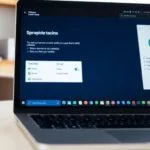When your network printer ceases to function, it can bring your productivity to a halt. Fortunately, there are a series of steps you can take to troubleshoot and potentially resolve the issue. This guide will walk you through the basic checks, connectivity solutions, advanced troubleshooting, and when to seek further assistance. Additionally, we’ll cover preventive measures to avoid future printer problems.
Key Takeaways
- Begin with basic troubleshooting steps like restarting your printer and checking Wi-Fi signal strength.
- Ensure network stability by assigning a static IP address to your printer and minimizing interference from other devices.
- Update your printer’s firmware and drivers, and consider a manual connection setup if automatic methods fail.
- If problems persist, seek help by consulting your printer’s web server or asking for community support with your WiFi settings.
- Adopt preventive measures such as regular updates and avoiding unnecessary changes to your printer’s network settings.
Starting with the Basics: Simple Fixes for Network Printer Woes
Restart Your Printer
We’ve all been there, right in the middle of a big project, and suddenly our trusty network printer decides to take a little nap. The first thing we should try is giving it a good ol’ restart. Just turn it off, count to ten, and power it back up. It’s like a mini vacation for your printer, and more often than not, it wakes up ready to tackle the job.
Sometimes, the simplest solutions are the most effective. A restart can clear out any minor glitches and get your printer back in the game.
If you’re working from multiple devices, make sure to give them a quick reboot as well. It’s not just about the printer; your computer, tablet, or smartphone could also be part of the problem. Here’s a quick rundown:
- Turn off your printer and wait a few seconds before turning it back on.
- For your computer or tablet, a simple restart can work wonders.
After you’ve done this, check if the printer has come back to life. If it’s still snoozing, don’t worry—we’ve got more tricks up our sleeve!
Check Wi-Fi Signal Strength
We’ve all been there, trying to print something urgently when suddenly the network printer just won’t cooperate. One of the first things we should check is the Wi-Fi signal strength. A weak signal can lead to intermittent connectivity issues or even prevent your printer from connecting to the network altogether. Here’s what you can do:
- Ensure your printer is within a good range of your Wi-Fi router. Walls and large objects can obstruct the signal, so try moving your printer to a more open location if possible.
- Check if other devices are experiencing low signal strength. If they are, the issue might be with the router or overall network coverage.
- If the signal is strong on other devices but not on your printer, consider checking for physical obstructions or electronic interference from other devices.
A simple yet effective step is to restart both your printer and Wi-Fi router. This can often refresh the connection and resolve any temporary glitches affecting signal strength.
Remember, at Omaha Computing Solutions, we’re here to help you with all your IT needs, including ensuring your wireless printer maintains a strong and secure connection to your network.
Ensure You’re Using the Default Printer
We’ve all been there, trying to print an important document only to realize it’s being sent to the wrong printer. It’s a simple mistake, but one that can cause a lot of frustration. Make sure your network printer is set as the default to avoid this common pitfall. Here’s how you can check and change your default printer settings:
- For Windows: Go to ‘Settings’ > ‘Devices’ > ‘Printers & Scanners’. Find your printer in the list, click on it, and select ‘Manage’. Then, click ‘Set as default’.
- For Mac: Click on the Apple menu > ‘System Preferences’ > ‘Printers & Scanners’. Right-click on your printer and choose ‘Set as default printer’.
Ensuring your network printer is the default one on your computer is a quick fix that can save you time and prevent unnecessary headaches.
If you’ve checked and your network printer is already the default one, but you’re still facing issues, it might be time to look into updating your printer drivers or operating system. Keeping everything up-to-date ensures better compatibility and smoother operation.
Update Printer Drivers and Operating System
We’ve all been there, trying to print something urgently when suddenly, the printer decides to take a day off. Often, the culprit is outdated software. Keeping your printer drivers and operating system up-to-date is crucial for smooth printing experiences. Here’s a quick checklist to ensure you’re not missing out on important updates:
- For Windows:
- Go to ‘Settings’ > ‘Update & Security’ > ‘Windows Update’.
- Click ‘Check for updates’.
- Install any available updates.
- For Mac:
- Click on the Apple menu and select ‘System Preferences’.
- Go to ‘Software Update’.
- Install any updates shown.
Updating isn’t just about getting the latest features; it’s about fixing bugs and improving compatibility with your devices. So, make sure to give your printer and computer a fresh start with the latest updates.
If you’re unsure about the process or need a hand, don’t hesitate to reach out to us. We’re here to help you tackle those troubleshooting printer issues and get back to printing without a hitch.
Tackling Connectivity: Establishing a Strong Network Link
Reset Network Settings on Your Printer
Sometimes, the solution to our network printer issues is as simple as giving it a fresh start. Resetting the network settings to their factory defaults can often clear up any connectivity problems we’re facing. Here’s how we can do it:
- Navigate to the printer’s control panel and find the ‘Network Settings’ or similar option.
- Look for an option that says ‘Restore Network Settings’, ‘Reset Network Settings’, or ‘Network Factory Default’.
- Confirm the action and wait for the printer to restart with default network settings.
After the reset, you’ll need to reconnect the printer to your Wi-Fi network. Make sure to have your Wi-Fi credentials handy, as you’ll need to enter them again. If you’re unsure about the steps, consult your printer’s manual or the online maintenance guide for your specific model, like the HP 8610 printer maintenance guide.
It’s crucial to ensure that the printer is properly reconnected to the network after a reset. If the printer doesn’t automatically reconnect, you may need to manually re-enter your Wi-Fi details or set up the connection anew.
Assign a Static IP Address to Your Printer
Having a static IP address for your printer is like giving your printer its own permanent home on the network. This way, every time you want to print something, your devices know exactly where to send the job. Here’s how we can set it up:
- Access your wireless router’s settings.
- Locate the DHCP server page and assign a static IP to your printer.
- Restart your printer to make sure it accepts the new IP address.
- Confirm the IP by logging into the printer’s web server or by pinging it from a command prompt.
Once you’ve assigned a static IP, you might need to remove and re-add the printer on your devices to refresh the network settings.
If you’re still having trouble, don’t hesitate to start a new topic in our support forum. We’re here to help you through every step of the process.
Remove Potential Interference from Other Devices
After ensuring your network printer is properly set up, it’s crucial to look at the environment it’s operating in. Wireless interference can be a sneaky culprit that disrupts your printer’s connectivity. Devices like microwaves, cordless phones, and even other wireless networks can interfere with your Wi-Fi signal.
To minimize interference, consider the following steps:
- Relocate your printer closer to the Wi-Fi router.
- Move other electronic devices that could cause interference away from the printer and router.
- Change your Wi-Fi router’s channel to one that’s less congested.
By taking these simple actions, you can create a more stable connection for your network printer, ensuring smoother operation and fewer interruptions.
Lastly, don’t forget to explore your router’s settings. Tweaking options like reducing the bandwidth on the 2.4 GHz band can increase range and stability, as some users have found success with this method. It’s all about finding the right balance for your specific setup.
Try a Direct Cable Connection
Sometimes, the best way to tackle a stubborn network printer issue is to bypass the network altogether. Going old school with a direct cable connection can be a game-changer, especially if you’re dealing with finicky Wi-Fi. Here’s a quick rundown on how to do it:
- Power off your printer and computer.
- Connect the printer to your computer using the appropriate cable—usually a USB.
- Power on both devices.
- Your computer should recognize the printer as a new device and may prompt you to install drivers.
If your computer doesn’t automatically recognize the printer, you’ll need to manually add it through your computer’s settings. This can often resolve communication issues, ensuring your documents print without a hitch—even if you’re not using one of our top-notch gaming computers.
This method is particularly useful if you’re in a pinch and need to print something urgently. It’s also a great way to test if the problem lies with the network or the printer itself. If the printer works fine when connected directly, you’ll know the issue is network-related.
Advanced Troubleshooting Techniques
Update Printer Firmware
We’ve all been there, staring at our computer printers, willing them to work. But sometimes, the solution is as simple as an update. Updating your printer’s firmware can be a game-changer, often fixing those pesky connectivity issues and enhancing your printer’s performance. It’s like giving your printer a fresh start.
To get started, you’ll want to check your printer manufacturer’s website for any available firmware updates. Follow their instructions carefully to ensure a smooth update process.
Here’s a quick checklist to guide you through the update:
- Verify your printer model and current firmware version.
- Download the correct firmware update from the manufacturer’s website.
- Follow the installation instructions provided by the manufacturer.
And remember, keeping your firmware up-to-date is just as important as those regular check-ups for your refurbished laptops. It’s all about maintaining peak performance for all your tech!
Manual Connection Setup
Sometimes, the best way to get your network printer back on track is to roll up your sleeves and dive into a manual connection setup. We’ve all been there, staring at our computer monitors wondering why things aren’t working. But fear not! Here’s a straightforward guide to manually connecting your printer to your Wi-Fi network.
For Windows users, start by opening the Control Panel from the Start menu. Then, click on “Devices and Printers“. Right-click on your printer and select “Printer properties”. Navigate to the “Advanced” tab and ensure that options like “Enable bidirectional support” or “Enable advanced printing features” are checked. Apply the changes and you’re good to go.
For our Mac friends, the process is just as simple. Make sure your printer is powered on and updated. Open “System Settings”, click on “Printers & Scanners” or “Print & Fax”, and add your printer by pressing the “+” button. Your Mac will search for available printers; select yours and follow the on-screen instructions. When asked, choose “Wi-Fi” or “Wireless” for the connection type and enter your Wi-Fi network details as prompted.
Remember, this manual setup is your ticket to regaining control when automatic processes fail. It’s a bit more hands-on, but it often does the trick!
Remove and Re-add the Printer on Your Computer
Sometimes, the solution to our network printer issues is as simple as starting fresh. Removing and re-adding the printer on your computer can often clear up any lingering configuration problems. Here’s how we can tackle this together:
- First, navigate to your computer’s printer settings. On Windows, you’ll find this in the ‘Devices and Printers’ control panel. For Mac users, head over to ‘System Preferences’ and select ‘Printers & Scanners’.
- Next, select your troublesome printer from the list and remove it. Don’t worry, it’s not going anywhere but out of the list.
- After that, add the printer back as a new device. If it’s a network printer, you’ll want to add it using its IP address to ensure a direct connection.
If you’re unsure about any of these steps or if the problem persists, don’t hesitate to reach out to us. We’re here to help you get back to printing without a hitch.
At Omaha Computing Solutions, we understand the frustration of technical hiccups. Whether you’re working with refurbished computers, refurbished desktop computers, or just trying to click with your computer mouse, we’re committed to smoothing out the process for you. Let’s get that printer back in action!
When All Else Fails: Seeking Further Assistance
Consulting the Printer’s Web Server
When you’re at your wits’ end with network printer issues, it’s time to dive a bit deeper. Accessing your printer’s web server can be a game-changer. It’s a nifty way to check settings and manage the printer remotely. Here’s how we at Omaha Computing Solutions do it:
- Open your favorite web browser.
- Enter the printer’s IP address into the address bar.
- Navigate through the settings to find what you need.
This approach lets you peek under the hood of your printer from the comfort of your used desktops Omaha. You can adjust settings, view printer status, and troubleshoot issues without needing to stand over the printer.
Remember, if you’re unsure about the IP address, you can usually find it on a network configuration page or by printing it directly from the printer. If that’s not working, a quick look at your router’s connected devices list might help. And if you’re using computers Omaha, make sure they’re on the same network as the printer for seamless connectivity. At Omaha Computing Solutions, we understand the frustration of printer problems, and we’re here to help you through every step.
Posting WiFi and Guest Network Settings for Community Help
When we’re stumped with our network printer issues, sometimes the best course of action is to seek help from the wider community. Posting your WiFi and Guest Network settings can be incredibly helpful, as long as you redact any sensitive information. Here’s how we can go about it:
- First, gather all the relevant settings from your router. This might include the model, firmware version, and any specific configurations you’ve made.
- Next, make sure to remove or obscure any personal information, like passwords or SSIDs that could identify you.
- Then, post your sanitized settings on a trusted community forum. You might be surprised at how quickly you’ll get a response!
By sharing your settings, you’re not only getting help but also contributing to a knowledge base that can assist others in the future.
Remember, while we’re all about fixing those pesky printer problems, we also have a great selection of used laptops Omaha can offer. If you’re in the market for Omaha used laptops, we’ve got you covered there too!
Preventive Measures and Best Practices
Regularly Check for Updates
We all know how frustrating it can be when our network printer decides to take a day off. To keep those days few and far between, we’ve got to stay on top of updates. Just like your favorite apps on your phone, your printer’s software needs regular check-ups to perform at its best.
Here’s a quick rundown on why this matters:
- Updates can patch up security holes, keeping your data safe from prying eyes.
- They often come with performance improvements, meaning faster and more reliable printing.
- Sometimes, new features are added that can make your life a whole lot easier.
It’s not just about fixing what’s broken; updates can breathe new life into your printer, giving it the pep it needs to handle your daily tasks with ease.
So, make it a habit to swing by the manufacturer’s website or use the printer’s built-in update function. It’s a small step that can save you a ton of time and headaches down the road. And hey, while you’re at it, give your computer a little love too—those device drivers aren’t going to update themselves!
Avoid Changing Printer’s IP Address Unnecessarily
We’ve all been there, tweaking settings here and there, but when it comes to your network printer, it’s best to keep the IP address consistent. Changing it without a good reason can lead to a cascade of issues, from devices losing connection to the printer to complications with Guest WiFi networks.
- Why stick to one IP?
- Ensures devices remain connected
- Avoids reconfiguring network settings
- Prevents Guest WiFi conflicts
If you’ve already changed the IP address and are facing problems, you might need to remove and re-add the printer on your devices. It’s a bit of a hassle, but it can clear up any confusion your devices might have. And hey, if you’re stuck, we’re here to help you sort it out—just reach out and we’ll tackle it together.
Pro tip: Before making any changes to your printer’s network settings, make sure you understand the potential impact on all devices connected to your network.
Consider Guest Network Implications
When we set up a guest network, it’s crucial to understand how it interacts with our main network and devices like network printers. Guest networks are designed to provide visitors with internet access while keeping them separate from your main network. This separation ensures security but can also lead to connectivity issues with devices that are not part of the guest network, such as your printer.
- Ensure that your printer is not accidentally connected to the guest network.
- If your printer supports it, set a manual IP address to avoid conflicts.
- Check if devices on the guest network need access to the printer and adjust settings accordingly.
In some cases, activating a guest network can cause interference with your main network, leading to packet loss or connectivity issues. It’s worth monitoring your network’s performance after setting up a guest network to ensure that all devices, including printers, maintain a stable connection.
Wrapping Up: Network Printer Troubleshooting
We’ve explored a variety of steps to take when your network printer refuses to cooperate. From restarting your printer to assigning a static IP, these methods are designed to tackle common issues that can disrupt your printing experience. Remember, sometimes the simplest solutions, like checking Wi-Fi signal or updating printer firmware, can make all the difference. If you’ve tried everything and still find yourself at an impasse, don’t hesitate to reach out for more help or consider consulting with a professional. Keep in mind that technology can be finicky, but with a little patience and the right approach, you’ll be back to printing in no time. Happy troubleshooting!
Frequently Asked Questions
What should I do if my network printer isn’t responding?
Start by restarting your printer and checking the Wi-Fi signal strength. Ensure it’s set as the default printer on your computer, and update the printer drivers and your operating system.
How can I establish a strong network connection for my printer?
Reset the network settings on your printer, assign a static IP address, eliminate interference from other devices, or try a direct cable connection.
What are some advanced troubleshooting techniques for network printers?
You can update the printer firmware, manually set up the connection, or remove and re-add the printer on your computer.
What should I do if none of the troubleshooting steps work?
Consult the printer’s web server for more detailed settings, post your WiFi and guest network settings for community help, or start a new topic for personalized support.
How can I prevent network printer issues in the future?
Regularly check for updates, avoid unnecessary changes to the printer’s IP address, and consider the implications of using a guest network.
What if my printer can’t print network information or connect to the network?
If you can’t print network information or connect, try assigning a static IP address and confirm it by pinging from a computer. If issues persist, remove and re-add the printer on your devices.








